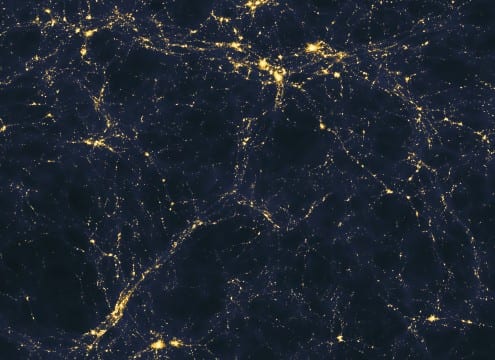Mapping the light of the cosmos
By Oli Usher, on 1 September 2014

This image shows one possible scenario for the distribution of light in the cosmos. Photo credit: Andrew Pontzen/Fabio Governato
Figuring out what the structure of the universe is surprisingly hard. Most of the matter that makes up the cosmos is totally dark, and much of what is left is in tiny, dim galaxies that are virtually impossible to detect.
This image shows a computer simulation of one possible scenario for the large-scale distribution of light sources in the universe. The details of how light (and hence galaxies and quasars) is distributed through the cosmos is still not a settled question – in particular, the relative contributions of (faint but numerous) galaxies and (bright but rare) quasars is unknown.
(New research from UCL cosmologists published last week shows how we should be able to find out soon.)
However, astronomers know that on the largest scales, the universe is structured as a vast web made up of filaments and clusters of galaxies, gas and dark matter separated by huge, dark voids. Observational astronomy is making strides forward in mapping out these structures in gas and light, but the smallest galaxies – less than a pixel across in the image above – might never be seen directly because they are simply too faint.
A Hubble image of a nearby faint dwarf galaxy (right) shows the challenge involved in observing these objects even when they are in our galaxy’s vicinity.
These computer models are one way of trying to extrapolate from what we know to what is really there. New research from UCL now shows how we can also use future observations of gas to find out more about this elusive population of tiny galaxies.
This simulated image shows the distribution of light in an area of space over 50 million light-years across. The simulation was created by Andrew Pontzen of UCL and Fabio Governato of the University of Washington.
Links
- UCL Physics & Astronomy
- UCL News story on finding the origin of the universe’s light
- In depth profile of the research on the UCL Mathematical & Physical Sciences website
 Close
Close



